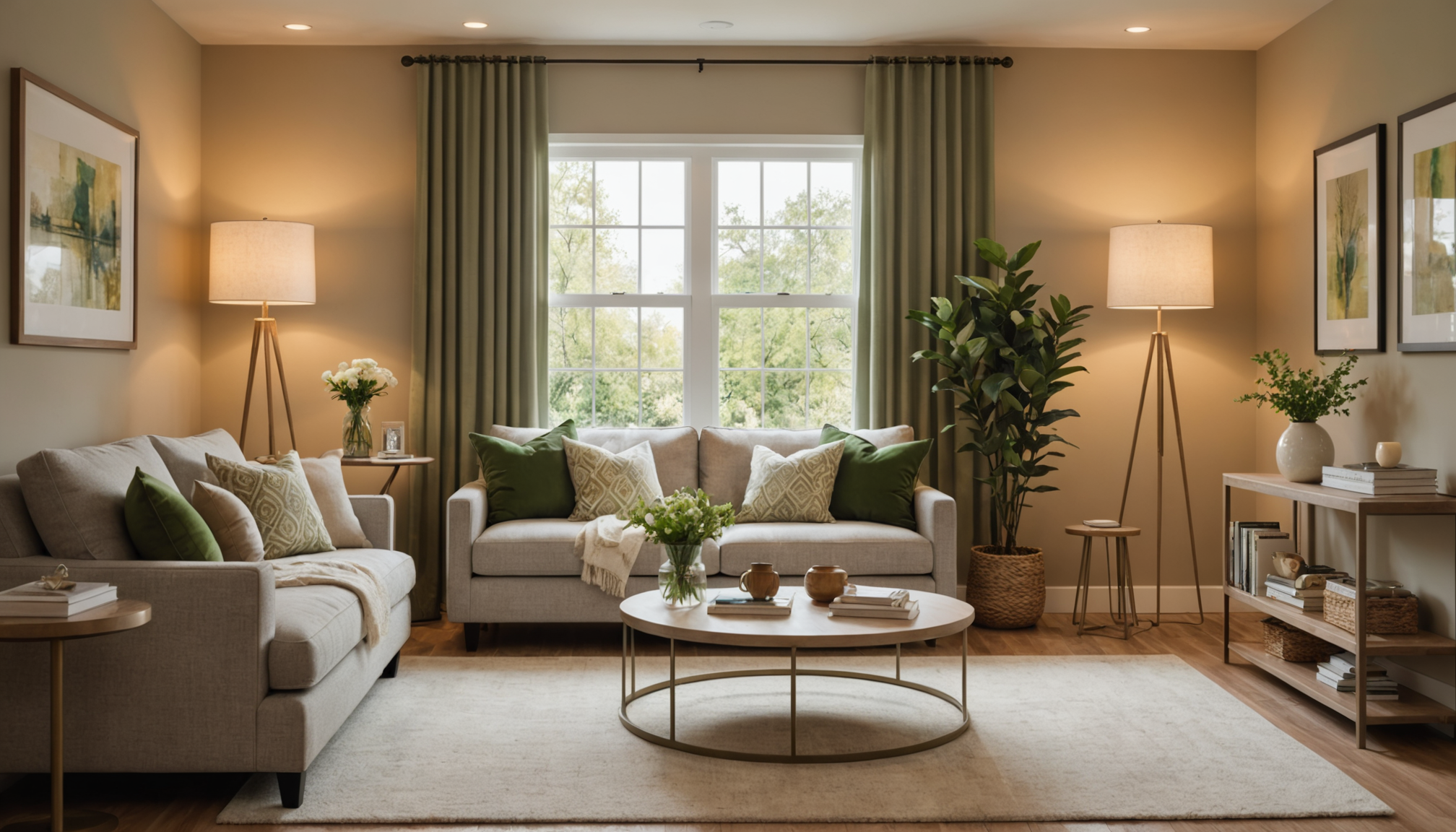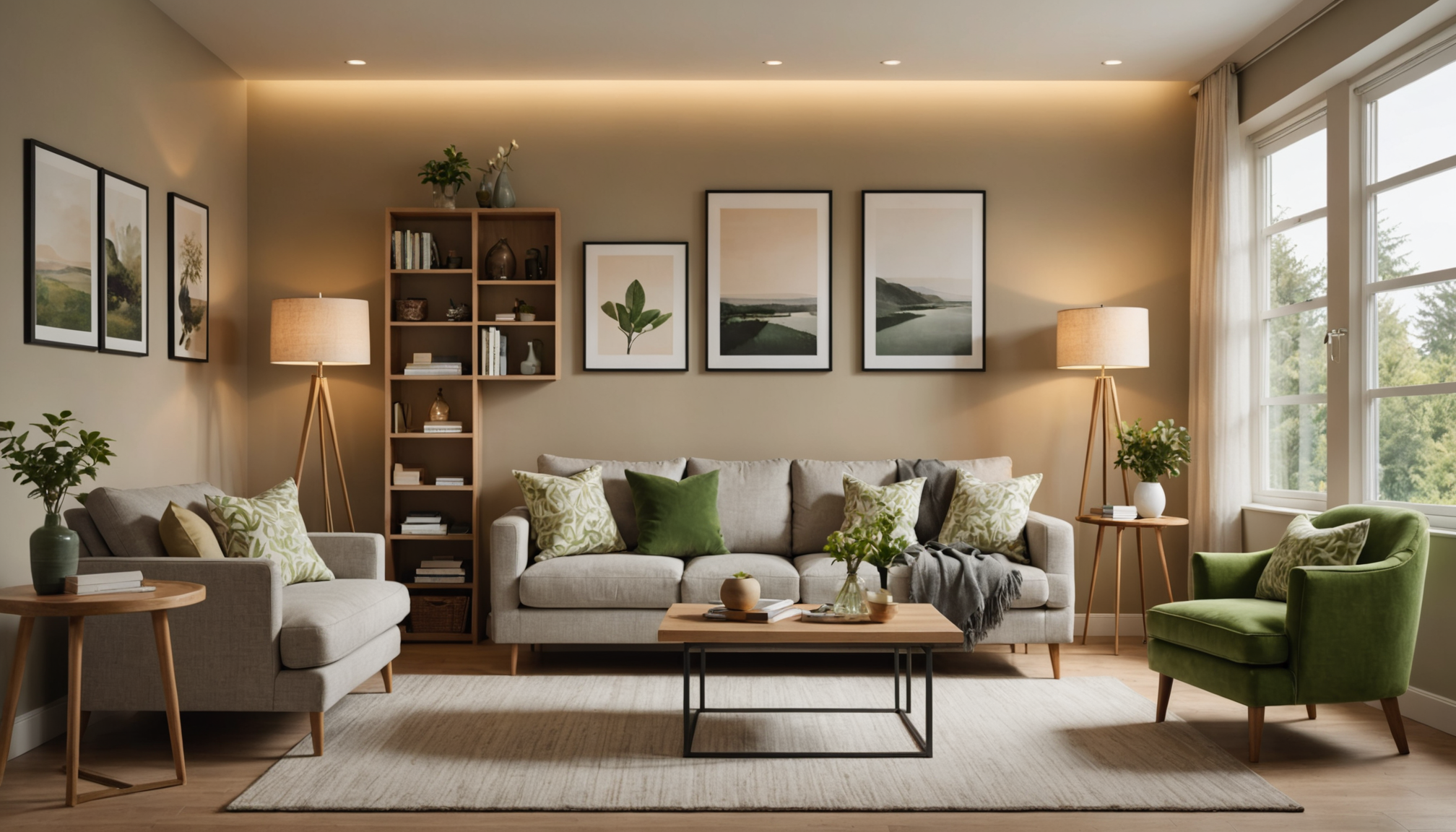Lighting is a crucial yet often overlooked element in home remodel projects that can drastically transform the ambiance of any room. As homeowners increasingly seek ways to optimize their living spaces for efficiency, aesthetics, and mood, understanding the role of interior lighting has never been more important. With almost 90% of our time spent indoors according to the U.S Environmental Protection Agency, the quality and quantity of light in our spaces can significantly impact our well-being and daily activities.
Beyond mere illumination, the right lighting can elevate a room’s design, enhance comfort, and even influence how a space is used. It’s important to start with a thorough evaluation of your current lighting setup to inform any decisions about upgrades or transformations. By understanding the existing conditions, you can make more informed choices and achieve a lighting plan that complements your lifestyle while boosting the overall visual appeal of your home.
The first step in the process is to assess your current lighting setup meticulously, which involves identifying areas where lighting is insufficient, overly bright, or inadequately distributed. Begin by walking through each room during different times of the day and take note of the following:
- The sources of artificial and natural light and how they interact within the space. Do you struggle with areas that are too dim or overwhelmingly bright?
- The types and locations of fixtures currently in use—are they serving their purpose effectively, or do they contribute to glare and uneven lighting?
- Consider your room’s purpose and whether the existing lighting supports its functional needs, such as task lighting in kitchens or ambient lighting in living areas.
- Evaluate the color temperature of your light bulbs. Are they warm and inviting, or do they cast an unflattering, harsh glow?
Aligning these observations with your intended atmosphere is critical. For instance, an inviting, warm ambiance may require layered lighting that blends task, ambient, and accent lighting, while a workspace might benefit from cooler, more focused light sources. According to the Illuminating Engineering Society, layering multiple types of lighting can create a dynamic environment that can be tailored to various circumstances and moods.
Also, consider the energy efficiency of your current setup. Are you utilizing outdated incandescent bulbs, or have you transitioned to more efficient LED options? LEDs offer not only energy savings but also a longer lifespan, reducing both environmental impact and ongoing costs. The Department of Energy notes that LED lights can cut energy use by 75% and last 25 times longer than incandescent lighting.
Once you have a comprehensive understanding of your current setup, you can start to envision potential improvements. This groundwork will enable you to approach the next steps confidently, ensuring that each choice aligns with the goals of your home remodel while enhancing the overall interior lighting plan.
choosing the right light fixtures
Selecting the right light fixtures is essential to both the functionality and aesthetics of your home remodel. When chosen wisely, these fixtures can enhance the interior lighting, elevate the ambiance, and align with the practical needs of each room. As you explore your options, consider not just the design but also how each fixture will contribute to the overall lighting scheme.
Focus first on the purpose of each lighting fixture. Every room has its own requirement based on its function, whether it’s task lighting for detailed work, ambient lighting to set a general mood, or accent lighting meant to highlight specific architectural features or decor. For instance, you might opt for pendant lights over a kitchen island to provide ample light for food preparation, while stylish sconces can add warmth and character to a living space.
Consider scale and proportion when selecting fixtures. Large rooms might benefit from chandeliers or large ceiling fixtures that make a bold statement, while smaller spaces may require more subtle recessed or flush mount fixtures to maintain balance without overwhelming the space. Harmony between the size of the room and the scale of your fixtures is crucial to achieve visual cohesion.
Style is another important factor that can drastically impact the ambiance. Fixtures come in a wide variety of styles, from contemporary and modern to vintage and industrial. Choose those that resonate with your personal taste and the overall design theme of your home. Mixing metals or finishes (like brass, nickel, or matte black) can add depth and texture to any room.
Energy efficiency shouldn’t be overlooked. Opting for fixtures compatible with LED technology will not only contribute to a more sustainable home environment but also lower utility bills and reduce maintenance due to their extended lifespan. Many modern fixtures come equipped with this capability, providing the dual benefit of form and function.
As you navigate the selection process, keep the long-term vision for your space in mind. The right fixtures should address both present needs and future adaptations, providing a flexible foundation as your household’s needs evolve. By evaluating both your personal preferences and practical needs, you can choose fixtures that transform any room’s ambiance while complementing the overall interior lighting scheme.
- Assess the purpose of each fixture – task, ambient, or accent lighting – to make informed choices that enhance functionality and atmosphere.
- Ensure fixtures are scaled appropriately for the size of the room; too large or too small can disrupt the visual balance.
- Select styles that align with your home’s theme; consider experimenting with mixed materials for added interest.
- Prioritize energy-efficient options, such as LED-compatible fixtures, to reduce environmental impact and maintenance.
- Keep long-term adaptability in mind to ensure fixtures will remain relevant as your needs change over time.
enhancing natural light solutions
Maximizing natural light is an essential component of a successful home remodel, offering not just aesthetic benefits but also enhancing the overall ambiance and energy efficiency of your home. However, several common mistakes can hinder the effectiveness of natural light solutions, so it’s crucial to understand these pitfalls and how to avoid them.
One of the most frequent missteps is failing to assess the potential of existing windows adequately. Many homeowners don’t realize the impact that small or obstructed windows can have on the flow of natural light into a room. To mitigate this, consider whether there are visual obstructions like heavy drapes, furniture, or exterior elements such as overgrown plants that could be repositioned or removed to enhance light penetration. Opt for light, airy window treatments that can be easily adjusted to control glare while maintaining the integrity of the natural light.
Another oversight is neglecting to consider the orientation of the windows. Depending on whether a window faces north, south, east, or west, the quality and quantity of natural light can vary significantly throughout the day. For example, south-facing windows provide consistent light, while north-facing ones may offer softer, more diffused light. Tailoring your interior lighting design to align with these natural patterns can help exploit the advantages each window offers.
Additionally, mirrors are a powerful yet underutilized tool for amplifying natural light. Placing mirrors opposite windows or using reflective surfaces—like glossy finishes on walls and furniture—can help bounce light around the room, making spaces feel larger and brighter. Avoid positioning mirrors in a way that causes glare or reflected images that disrupt the room’s ambiance. Instead, focus on strategic placements that double the benefit of your natural light.
Window treatments themselves can become a barrier when homeowners select options that do not cater to the room’s lighting needs. Avoid heavy fabrics in favor of lighter materials, such as sheer or cellular shades, which allow light to filter through while maintaining privacy. These choices can improve the interior lighting while enhancing the room’s visual appeal and warmth.
Ignoring the impact of colors is another common mistake. In rooms where natural light is limited, using dark paint colors can make a space feel smaller and more enclosed. Conversely, light tones—white, cream, pastel, or other soft hues—can reflect light and create an airy, open atmosphere. Selecting the right color palette can substantially transform a room’s ambiance, complementing the natural light available.
Lastly, failing to integrate these solutions into an overall cohesive lighting plan can result in disjointed or ineffective enhancement results. Natural light should be considered a part of layered lighting, working in harmony with artificial sources to create a balanced and bright environment. By combining well-placed fixtures and natural solutions, you can establish a versatile, dynamic interior lighting arrangement that adapts to different times of the day and functions within your home.
In summary, to maximize the transformative power of natural light, it’s important to recognize and rectify these common mistakes. By thoughtfully enhancing natural light through strategic assessments, design choices, and harmonious integration, you can elevate the atmosphere and functionality of any remodelled space.
integrating smart lighting technology
Integrating smart lighting technology into your home remodel can revolutionize the way you experience interior lighting and enhance the ambiance of any room. Smart lighting systems allow you to control the lighting environment with ease, providing unparalleled flexibility and efficiency. At their core, these systems are designed to improve daily life by offering customizable and dynamic solutions that are both functional and aesthetically pleasing.
One of the primary benefits of smart lighting is the level of automation and control it offers. Through the use of apps on smartphones or voice-activated assistants like Alexa or Google Home, you can adjust the lighting according to your personal preferences without physically interacting with the fixtures. This can include altering the brightness, changing color temperatures, or setting schedules that align with your daily routines. For example, set your lights to gradually brighten in the morning for a gentle wake-up or dim in the evening as you wind down. This kind of control over your environment not only enhances convenience but also plays a role in setting the right ambiance for every occasion.
Another significant advantage is energy efficiency. Smart bulbs, especially LED variants, can drastically reduce energy consumption as they use a fraction of the power needed by traditional incandescent bulbs. Moreover, the ability to remotely control and automate lighting means less energy is wasted when lights are inadvertently left on, supporting a greener home remodel. Some systems offer insights and analytics on energy usage, helping you identify patterns and optimize your lighting further to conserve power and reduce bills.
The adaptive nature of smart lighting also plays a crucial role in flexibility and customization. Imagine adjusting the warmth of light from cool and invigorating for a productive workspace to warm and cozy for relaxation—all at the touch of a button or with a simple voice command. This adaptability ensures that your lighting can evolve according to your needs, preferences, and activities, keeping your home viable and vibrant regardless of changing requirements.
The integration of smart sensors adds another layer of intelligence, allowing lights to respond automatically based on the presence of people in the room or changes in natural daylight. These sensors can adjust the lighting output depending on the amount of sunlight streaming through your windows during the day or automatically turn off lights when a room is unoccupied, providing both convenience and further energy savings.
In terms of installation, smart lighting technology is increasingly user-friendly, making it accessible even to those who aren’t technology experts. From plug-and-play systems to more complex, fully integrated solutions, there’s a wide range of options to suit various budgets and technical preferences. These possibilities make adopting smart lighting an achievable aspect of modern home remodel projects.
As you embrace smart lighting, be mindful of your interior design goals and how technology can complement them. Whether it’s enhancing the tranquility of a bedroom or boosting the functional light in a kitchen, smart lighting should harmonize with your existing decor and design elements.
By integrating smart lighting technology, you’re not only elevating the aesthetics and functionality of your interior lighting but also aligning your home with modern convenience and sustainability. Start small by replacing a few key lights with smart bulbs, and as you grow comfortable, expand the system throughout your home. With the right plan in place, smart lighting can redefine your living spaces, offering limitless possibilities to create environments that reflect your lifestyle and aspirations. So, push the boundaries of what lighting can do for you, and let innovation illuminate the future of your home.
creating ambiance with layered lighting
Layering lighting is a fundamental and versatile approach to maximizing the impact of your interior lighting during a home remodel. It involves carefully combining different lighting sources—ambient, task, and accent lights—to create a harmonious and adaptable atmosphere. By thoughtfully integrating these elements, you can effortlessly transform a room’s ambiance, accommodating a range of activities and moods.
Ambient lighting serves as the foundation, providing overall illumination necessary for safe navigation throughout the room. This is typically achieved with ceiling fixtures such as chandeliers, pendants, or recessed lights. For a softer effect, consider using dimmable light sources, which allow you to adjust the intensity throughout the day, catering to various needs and preferences.
Task lighting is indispensable for areas where focused activities occur, such as reading, cooking, or working. This type of lighting is typically more concentrated and direct, ensuring sufficient brightness for activities that require precision and detail. Under-cabinet lights in the kitchen or a dedicated desk lamp in a study are prime examples. When planning task lighting, direct the light efficiently while minimizing glare or casting excessive shadows.
Accent lighting injects personality and drama, highlighting specific features or areas such as artworks, bookcases, or architectural elements. Track lighting, spotlights, or wall-mounted lights can draw attention to these features, adding depth to a room’s design. Accent lighting’s primary function is to create points of interest while enhancing the aesthetic qualities of your space.
Color temperature plays a crucial role in setting the mood. Warm light sources (around 2700K to 3000K) create a cozy and inviting ambiance ideal for living spaces and bedrooms. Cool light sources (above 4000K) are preferable for task-oriented areas like home offices or kitchens, where clarity and focus are needed. Balancing these temperatures through layered lighting adds versatility, allowing spaces to transition smoothly from daytime activities to evening relaxation.
Finally, don’t underestimate the influence of lighting control systems. Incorporating smart dimmers or wireless switches can facilitate effortless adjustments to the lighting layers, accommodating different occasions with a touch of a button or voice command. Such systems enhance convenience and energy efficiency, allowing you to fine-tune the ambiance to suit various scenarios seamlessly.
Striking the right balance with layered lighting enhances both form and function in any room, offering flexibility and sophistication. By understanding and applying these principles during your home remodel, you can effortlessly curate an atmosphere that adapplies to your lifestyle and elevates the overall design.
- How can layered lighting improve the ambiance of my home?
- Layered lighting combines different types of lighting—ambient, task, and accent—to create a dynamic and adaptable environment. It allows you to tailor the ambiance to suit various activities and moods by adjusting the lighting intensity and highlighting specific areas or features.
- What’s the best way to choose light fixtures for different layers?
- Focus on the purpose of each lighting type. Ambient lighting should provide broad illumination, task lighting must be concentrated for specific tasks, and accent lighting should highlight key features. Consider style, scale, and energy efficiency to ensure they fit both your aesthetic and functional needs.
- How does color temperature affect room ambiance?
- Color temperature influences the mood of a room significantly. Warm lighting creates a cozy and relaxing atmosphere, ideal for bedrooms and living areas, while cool lighting enhances alertness and is suitable for workspaces. Mixing these temperatures through layered lighting can offer versatility and adaptability.
- Can smart lighting be integrated into layered lighting schemes?
- Yes, smart lighting is an excellent addition to layered lighting, offering precision control over brightness, color temperature, and scheduling, enhancing both convenience and energy efficiency. Smart systems allow you to adjust ambiance effortlessly to suit any occasion with ease.
- What are some practical considerations for installing layered lighting?
- Ensure each lighting layer serves a clear purpose and complements the room’s decor. Prioritize dimmable fixtures or incorporate smart controls for enhanced flexibility. Pay attention to fixture size and spacing to maintain visual harmony and avoid cluttering the space.











